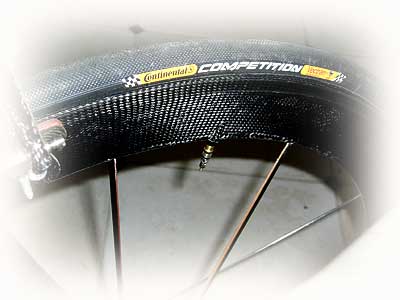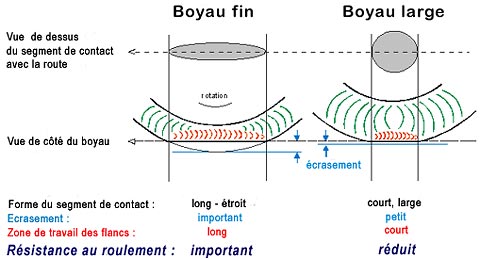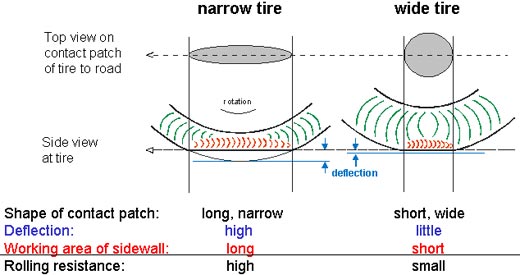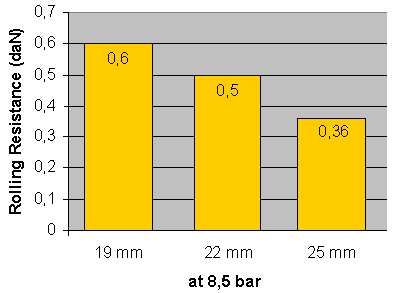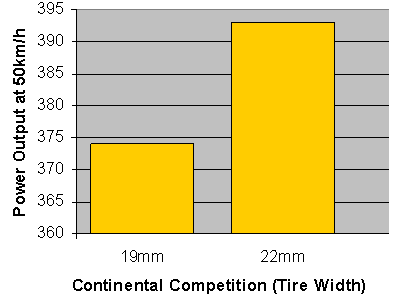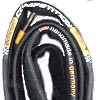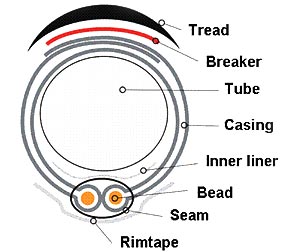For
this reason, building a whole marketing event aimed
at cynical cycling journalists is potentially a risky
proposition, but for those teams in Paris Roubaix riding
on Continental tyres - T-Mobile, Credit Agricole, Phonak
and Saunier Duval - no rider could point to an ill-timed
puncture.
According
to a report in the British Cycling Weekly, these sponsored
teams 'only' suffered two flats each in the 2005 race,
compared to the usual average of eight flats per team
in Paris-Roubaix.
Competition-ready
Tubular tyre construction
Rolling resistance measurements for two of Continental's
high-end tyres show the Competition tubular has lower
rolling resistance than the Grand Prix 300 clincher
Tyre rolling resistance decreases as tyres become fatter,
according to Continental's measurements.
Figures from an SRM power meter show that at 50km/h
a narrow tyre requires less power than a fatter one.
Rolling resistance may be lower for the fat tyre, but
the narrow rubber's superior aerodynamics more than
makes up for it
Continental used Paris-Roubaix to introduce a new 'Competition'
model tubular: a 25mm tyre with a double layer of Vectran,
a hi-tech material that is said to offer significantly
better puncture resistance than Kevlar and other materials.
The
thin Vectran layer resides between the tyre casing and
the outer tread. The German company recognised Vectran's
strengths, but producing it so it could be used in lightweight
bicycle tyres required over two years R&D, resulting
in a secret and patented process.
The
first tyres to use this layer were used by the professionals
in the 2005 Paris-Roubaix, and the day before by a group
of journalists who all survived their cobbles experience
(see separate story).
Like
many bicycle components (or anything performance-oriented,
for that matter) the production of a tyre is a compromise
of weight over strength. Yes, tyre companies could make
a tyre that would be virtually impervious to punctures,
but it would be heavy and slow.
But
what do we mean by "slow"? How can a tyre
be "slow" - isn't it the rider? Well yes and
yes; a tyre casing that would be puncture-proof would
either be solid or so thick as to have the responsiveness
of a gumboot. A tyre still changes its shape when it
rolls down the road - regardless of the inflation -
and the energy that is required to make the tyre change
its shape is determined by its thickness. Therefore,
a thick tyre casing requires more energy than a light
casing. More energy absorbed = slower tyre.
The
challenge, therefore, is to make a tyre capable of handling
high pressure, but still be light and puncture resistant.
There are other requirements like longevity and grip,
but a racing bicycle tyre's intrinsic shape and weight
mean those qualities are almost always sacrificed in
the name of performance. We're not talking Moto GP here.
Tyres don't go off or get shredded by 180hp engines.
(Of course if you can have grip without compromising
weight and speed, then that's a bonus, and tyre development
in the last 20 years has seen substantial improvements
in rubber compounds.)
After
wind resistance, a tyre's rolling resistance is the
cyclist's next best enemy, and Continental presented
some research results that explode some myths about
tyres and rolling resistance.
Conti's
figures further demonstrate how tyre design and construction
- even at the high-end - is still a compromise of conflicting
objectives. Continental's numbers support the widespread
belief that tubular tyres are faster than clinchers,
but most surprising was research that showed how wider
tyres have less rolling resistance. For example, a 25mm
tubular offers less rolling resistance than 22mm and
19mm tyres (see graph).
But
when a bicycle and rider build up velocity, resistance
is not as important as aerodynamics, and wind resistance
becomes the all-important factor. For this reason, Continental
found that - conversely - a thinner tyre requires less
energy than a fatter tyre to travel at 50kmh, principally
due to aerodynamics (see graph).
For
this reason, Continental believes the fastest combination
of tyres is to have a 19mm front and 22m (reflected
in its Grand Prix Attack/Force combination that use
a 22mm front/23mm rear combination - see review). But
this combination was proven on the velodrome in Buttgen,
Germany. In the real world, there are factors such as
comfort, grip and not the least, puncture resistance.
What
is Vectran?
Which brings us to improving a tyre's puncture resistance
without impacting its performance. Continental clearly
believes it has the edge with the use of Vectran, and
while it is only available in the 25mm "Competition"
tubular, executives hinted at its likely introduction
into other tyres in the range.
Vectran
is - for the chemists out there - a "wholly aromatic,
liquid crystal polymer, derived from polyester"
that's five times stronger than steel. As a puncture-prevention
layer in a tyre, Vectran is said to have the edge over
materials like Kevlar because of its near-zero moisture
absorption and fatigue performance. It is also said
to have better resistance to folding and buckling -
essential if it is going to be used in high-pressure
bicycle tyres.
Conti
believes the material is also superior as a 'breaker'
material because it is more cut resistant (see table)
but still light and thin so it can be used in bicycle
tyres without adversely affecting the tyre's weight,
rolling resistance and overall performance. In short,
it is something of a breakthrough that is likely to
be featured in more products, but only for the road.
Special track and time trial models are unlikely to
feature the new material.
Time
will tell if it is more than a marketing gimmick, but
given Continental's background in bicycle tyres, it
is something the company believes will give it the edge
for years to come.
More
on 'fat tyres have lower rolling resistance'
Everyone knows skinny tyres are faster, so the notion
that fat tyres have lower rolling resistance seems counterintuitive
to many cyclists. As we've seen above, at racing speeds,
narrow tyres need less energy to maintain a speed, so
how does this fit with measurements showing higher rolling
resistance?
The
first thing to remember is that at 50km/h rolling resistance
is only a small portion of the forces acting against
a cyclist. Rolling resistance increases roughly proportionally
with speed, while air resistance increases as the cube
of speed. Double your speed and your tyres' rolling
resistance doubles - but the air resistance goes up
eight times! Air resistance dominates at racing speeds
and narrow tyres are faster.
A
fat tyre gets its lower rolling resistance from the
shorter perimeter of its contact patch.
To
understand why the rolling resistance component is lower
for fat tyres, we need to understand where rolling resistance
comes from. As your tyre tread and sidewall bend on
contact with the road, they absorb energy. When they
straighten out, they spring back and return most of
that energy - but not all of it. Some of it simply gets
turned into heat, and that lost energy is the rolling
resistance.
For
a given tyre pressure and rider weight, all tyres have
about the same area in contact with the ground. If you
and your bike weigh 200lb and you have 100 pounds per
square inch of pressure in your tyres, you're in contact
with the road over two square inches of rubber (apologies
to people who think in metric, but Imperial units are
so convenient for this stuff!)

